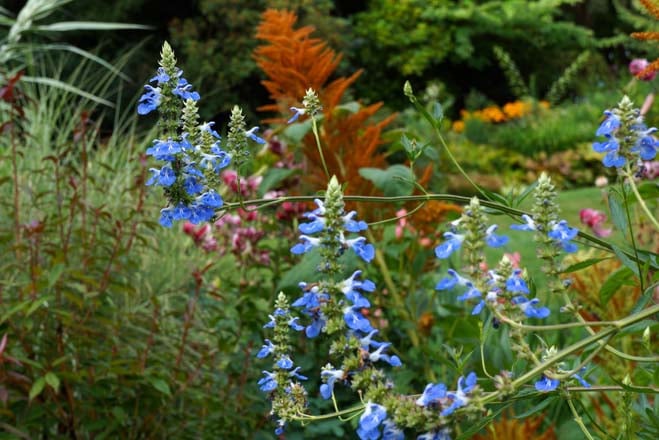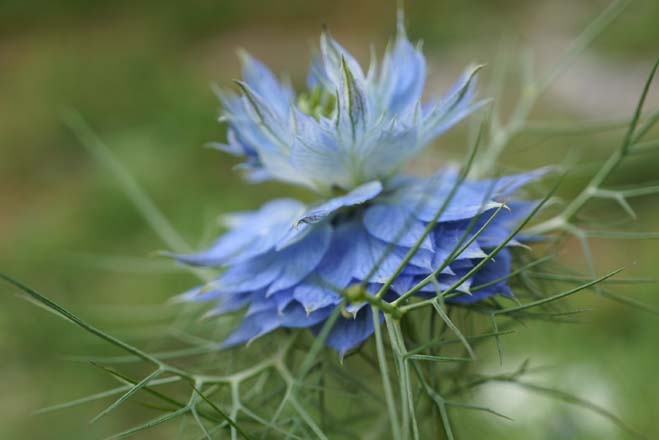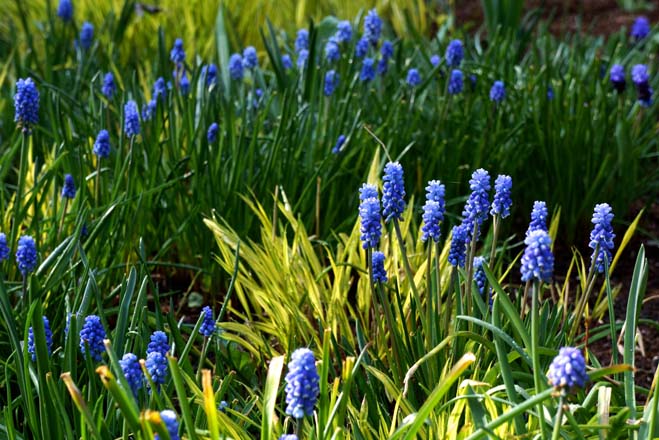
A Gardener Comes to Terms with Blue

Contributor

The first time I heard Joni Mitchell’s “Blue” was in July of 1972 as I sat cross-legged in denim cutoffs on the floor of my cool basement bedroom. As she elongated the pure and simple word blue, dropping through whos and oos, her singing became the color, and that color a mood. Blue, I love you, I wailed along with Joni in a voice that cracked and quavered. I was losing my childhood falsetto, my innocence, and my eye for red. I was growing up, finding my cool, and falling in love with blue.
I hated the Midwest midsummer heat, so I hid in my dark basement room all day reading and listening to Joni Mitchell. It made my mother worry. She would pry me from my lair, commanding me to weed the vegetable patch. Under the blistering sun, I sought coolness among the blue flowers of her garden. I found it in the faithful self-sown bachelor buttons, in the gentle pansies my mother would plant each spring in the shade of the garage, and in the happy morning glories tangling through our neighbor’s chain-link fence.

“The blues come in two cadences, happy and sad,” says garden designer Mary Keen. We call the saddest of music The Blues. Yet we yodel with joy under a blue sky. And it is the bluebird that brings happiness, not the fiery cardinal.
Yet blue can be a lonely color. It is the only cool hue among primary colors. No color is moodier than blue, which can inspire reflection, or inflict depression.
Yet blue also reaches for soul-lifting heights. A few years ago, while hiking with my partner Michael through the cloud forests of Mombacho Volcano in Nicaragua, a rare blue morpho butterfly came into view—more a visitation, than a sighting. It casually vanished into the jungle after a few clean and holy moments.
Blue is holy and clean.
The Virgin Mary is traditionally cloaked in celestial blue. And Vishnu the blue-skinned god of the Hindus is considered the supreme soul, the all-pervading essence of all beings. The Buddha’s throne is a blue lotus. And heaven itself is often depicted as a blue eternity punctuated with white fluffy clouds for resting.
When I talk of blue, you realize, I mean true primary blue, or those blues diluted with white or fortified with black, not the blues tainted with pink, or lit up with yellow. I list turquoise and periwinkle among my favorite colors, but consider neither blue. True blue, so rare in nature, finds its most glorious expression in flowers: forget-me-nots, sages, and gentians.
My, how we love blue flowers.
I can complain with the well-tempered gardener Christopher Lloyd, “Blue flowers are in such demand, are such certain sellers, that nurserymen have to stretch the interpretation of the word to the snapping point.” Plant catalogues continue to trick us with filtered photos, and with that most tempting of words, “blue,” when describing lavender, purple, and violet flowers—not to mention “blue” foliage. I’m sure many of you have felt the disappointment: a promising blue flower blooms a dull and lifeless violet, nearing true blue, yes, but just enough to be irritating, not satisfying.
It’s saddening.

Yet joyful are they who pursue the true blues. While some may be had for mere pennies and little effort like bachelor buttons, love-in-a-mist, and borage, we Northwest gardeners are geared toward the impossible. We grab for Himalayan blue poppies, agapanthus, and alpine gentians, when trailing lobelia would do.
In an effort to keep up with contemporary design trends, we buy blue-glazed pots from China or paint walls blue in imitation of gardens from warmer climes like La Majorelle in Marrakesh. The hottest flame may be blue but no amount of blue can change our climate. The color blue is cool. Many garden designers eschew blue gardens as “too somber,” “lifeless,” and “dull.” And in my opinion, too much blue chills a Northwest garden that is often sullen enough under our beloved gray skies.
Bride M. Whelan, color theory instructor at Parsons School of Design in New York, says, “Blue, whatever its tint or shade, is the hue most often associated with authority and security, truth and wisdom.” Blue is as powerful as a Prussian uniform. Blue sets the standard with Blue Book values, blue ribbons, and even blue bloods. Blue is as magical as an Egyptian lapis amulet, or the blue moon.

Garden colorist Nori Pope croons, “Blue sits easily in the landscape because it is so close to the main field color of green.” While Louise Beebe Wilder warns that blue flowers “seem to have no edges.” Blue can easily be lost among the greens of the garden. Blue needs colorful companions to keep it upbeat and active.
I love blue with cream or pale acidic yellows. And like many garden designers, I try to keep blue at a distance from its closest kin, purple, lavender, and violet, which seem to rob it of its dignity.
Yet, I don’t trust blue. I have seen the azure surface of the Mediterranean go leaden with waves. And the joy of a blue October sky over Seattle suddenly muffle with endless clouds. Blue is as ephemeral as it is eternal. Maybe that is why blue holds a spell over us and begs to be sought out.

In summer, when I visit the wet subalpine meadows of the Cascades, a cluster of bog gentian keeps me as rapt as the panorama of snow-capped peaks surrounding me. And, in my mind, a patch of vivid blue Phacelia blooming in the Sonoran desert dwarfs the majestic colonnades of saguaros. Back in my childhood rust-belt neighborhood, I held the chicory of vacant lots as dear as any of our garden flowers simply because it was such a luminous blue.
But we gardeners are not happy with a few blue wildflowers. We want blue dahlias, blue tulips, blue lilies, and even blue marigolds. And, of course, blue roses.
Blue flowers sell. The biotechnology company Florigene of Australia, in partnership with the Japanese brewing company Suntory, has spent tens of millions of dollars over two decades trying to breed a blue rose. The resulting Applause™ rose, which they created by adding blue pansy genes to a rose breeding program, is a disappointing lavender. Still, this supposedly “blue” rose costs nearly 20 dollars a stem at floral shops.
I’ll stick with the cheap and easy blues of bachelor buttons, love-in-a-mist, and borage.
It is the paucity of blue in nature that I think is its very strength, its rarity that excites. Among the flaming oranges and reds of autumnal foliage in my garden, the last few sky blue flowers of bog sage break the spell of the low-hanging gray clouds of October.
Share:
Social Media
Garden Futurist Podcast
Most Popular
Videos
Topics
Related Posts

Low Maintenance Gardens – Better for Pollinators and People
Autumn 2022 “I come out every day. It’s therapy, my meditation.” Janet’s young garden transformed from overgrown, invasive plants to mostly natives. The dailiness of

Calochortophilia: A Californian’s Love Affair with a Genus
Summer 2022 I can chart the progression of my life by Calochortus. For the last two decades, at least. As a teenage girl growing up

Pacific Plant People: Carol Bornstein
Spring 2022 Public gardens play a key role in demonstrating naturalistic planting design, selecting native and adapted plants for habitat, and testing techniques for reducing

Add Year-Round Interest and Winter Blooms for Pollinators
Spring 2022 This article was created from an Interview by Merrill Jensen with Neil Bell in the Summer of 2021 for our Pacific Plant People











Responses